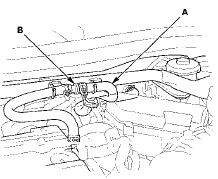 Honda Accord: Brake Booster Test
Honda Accord: Brake Booster Test
Functional Test
1. With the ignition switch in LOCK (0), press the brake pedal several times to deplete the vacuum reservoir, then press the brake pedal hard and hold it for 15 seconds. If the brake pedal sinks, either the master cylinder is bypassing internally or the brake system is leaking. Inspect the brake hoses and lines (see page 19-39).
2. Start the engine with the brake pedal pressed. If the brake pedal sinks slightly, the vacuum booster is operating normally. If the brake pedal height does not vary, do the brake system test (see page 19-4).
Leak Test
1. Press the brake pedal with the engine running, then turn the ignition switch to LOCK (0). The brake pedal height should not vary while pressed for 30 seconds.
- If the pedal height rises, go to step 6.
- If it does not rise, go to step 2.
2. Start the engine and let it idle for 30 seconds. Turn the ignition switch to LOCK (0), and wait 30 seconds.
Press the brake pedal several times using normal pressure. When the pedal is first pressed, it should be low. On consecutive applications, the pedal height should gradually rise.
- If it rises, the booster is OK.
- If it does not rise, go to step 3.
3. Disconnect the brake booster vacuum hose (A) at the booster. The check valve (B) is built into the hose.
NOTE: If the check valve is faulty, replace the brake booster vacuum hose/check valve as an assembly.

4. Start the engine, and let it idle. There should be vacuum available.
- If no vacuum is available, the check valve is not working properly. Replace the brake booster vacuum hose and the check valve, and retest.
- If vacuum is found, go to step 5.
5. With the ignition switch in LOCK (0), reconnect the vacuum hose to the brake booster.
6. Start the engine, and then pinch the brake booster vacuum hose between the check valve and the booster.
7. Turn the ignition switch to LOCK (0), and wait 30 seconds. Press the brake pedal several times using normal pressure. When the pedal is first pressed, it should be low. On consecutive applications, the pedal height should gradually rise.
- - If the pedal position does not vary, inspect the seal between the master cylinder and the booster. If the seal is OK, replace the brake booster.
В« If the pedal position varies, replace the brake booster vacuum hose/check valve as an assembly.
 Master Cylinder Inspection
Master Cylinder Inspection
1. Remove the master cylinder (see page 19-26).
2. Inspect and note these items:
- Before reassembling, check that all parts are free of
dirt and other foreign particles.
- Do not try to disas ...
 Brake Booster Replacement
Brake Booster Replacement
1. Remove the cowl cover (see page 20-278).
2. Remove the strut brace (if equipped) (see page
20-306).
3. Remove the master cylinder (see page 19-26).
4. Disconnect the brake booster vacuum ...
See also:
Rear Seat Side Bolster Cover
Replacement
4-door
NOTE: Take care not to tear or damage the seat covers.
1. Remove the seat side bolster (see page 20-242).
2. Release all the hook strips (A), fold back the seat side
bolster cover (B), ...
Driver's Under-dash Fuse/Relay Box
(MICU) Removal and Installation
Special Tools Required
Relay Puller 07AAC-000A1A0
USA models
NOTE; SRS components are located in this area. Review
the SRS component locations 4-door (see page 24-21),
2-door (see page 24-23), an ...
To Stop Playing Your iPod
To play the radio, press the FM/AM,
or button. Press the CD button
to switch to the disc mode. Press the
AUX button to switch back to the
iPod.
Disconnecting an iPod
You can disconnect the ...
